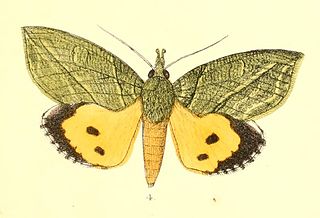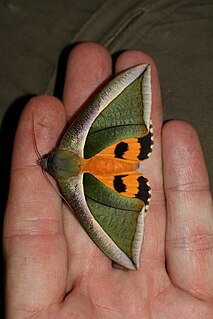
Cajeta is a confection of thickened caramel usually made of sweetened caramelised goat's milk. It is a type of dulce de leche. In Mexico, it is considered a specialty of the city of Celaya in the state of Guanajuato.

Eudocima is a genus of moths of the family Erebidae first described by Gustaf Johan Billberg in 1820.

Eudocima phalonia, the common fruit-piercing moth, is a fruit piercing moth of the family Erebidae. The species was first described by Carl Linnaeus in his 1763 Centuria Insectorum. It is found in large parts of the tropics, mainly in Asia, Africa and Australia but introduced into other areas such as Hawaii, New Zealand and the Society Islands. It is one of major fruit pests in the world.

Eudocima hypermnestra is a moth of the family Erebidae described by Pieter Cramer in 1780. It is found in China, Thailand, Taiwan, India and Sri Lanka.

Eudocima salaminia, the green fruit-piercing moth, is a moth of the family Erebidae. The species was first described by Pieter Cramer in 1777. It is found from India, and across south-east Asia to the Pacific Islands. In Australia it occurs in the Northern Territory, Queensland and New South Wales. The adult is a fruit piercer.

Eudocima procus is a moth of the family Erebidae described by Pieter Cramer in 1777.






